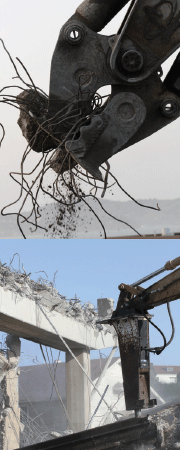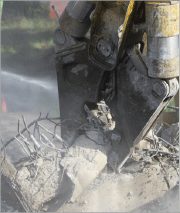The 1.5 miles of roadway that connects the Golden Gate Bridge with San Francisco, known as Doyle Drive, was closed at 8 a.m. Friday, April 27 until 5 a.m. Monday, April 30 for demolition, making way for a temporary bypass. Eventually, the temporary bypass will be replaced by a more seismically stable structure called the Presidio Parkway, scheduled to open by the end of 2015.
A total of 65,000 tons of concrete was demolished and removed to make way for the temporary bypass.
“This is one of the biggest operations that I’ve ever been involved with,” says David Pang of the California Department of Transportation (Caltrans). “Demolishing 3,300 feet of concrete viaduct in basically less than 24 hours—that’s an amazing feat.”
Doyle Drive is the southern approach to the Golden Gate Bridge that opened along with the Golden Gate Bridge in 1937. It had been identified as one of the most seismically-unsafe roadways in the state of California. Caltrans shut it down and began tearing down pretty much everything between Highway 1 and Marina Boulevard on a Friday evening and reopened the area with a temporary bypass the following Monday morning.
 Several different attachments were used during the Doyle Drive project. Several different attachments were used during the Doyle Drive project. |
“The timeframe was what made this difficult,” says Marc Ferrari, president of Ferma Corp., Mountain View, Calif. “We basically had 24 hours to get three critical spots cleared so they could build the brand new road. We destroyed somewhere around 65,000 tons of concrete and miscellaneous pieces.
“The amount of work for this time frame was absolutely insane,” Ferarri adds. Crews ran three 12-hour shifts in a row to get the demolition work done so the temporary road could built before the Monday morning commute.
During demolition, hundreds of joggers, dog walkers and spectators lined the construction zone to take in the interesting and unusual show. Cheers were heard as giant excavators, their hydraulic arms fitted with various attachments, knocked down Doyle Drive with agility and speed.
In the middle of the 24-hour demolition time frame was Stanley LaBounty, Two Harbors, Minn. Ferma operated 12 different LaBounty attachments on this job. Among the LaBounty attachments in action were metal shears, concrete demolition Universal Processors (UP), large mounted pavement breakers and LaBounty’s newest concrete demolition attachment, the MDP30 (Mobile Demolition Processor).
Ferma utilized a UP 75 to cut girders in the ground as well as a 3000R, a 7500R and a 2000R.
“We couldn’t have done the job without LaBounty products,” states Ferrari. “Their forces were phenomenal. They were cutting columns in single passes.”
An MDP30 was on site to perform the processing needed to drop the sections of the roadway. “The great thing about those big tools is they rotate and they have big jaws, so we were able to get around the 32-inch columns we had out here,” says Ferrari.
Pang says the equipment was unlike anything he had ever seen. “When the equipment started coming in a couple of weeks before we started this operation, we were amazed,” he recalls.
Shears were quickly put to work clipping columns and breaking down the girders. Byron Linn Caltrans says he was surprised at how the shears were able to demolish 4,000 psi (pounds per square inch) concrete. “With this shear, it just crumbles like cookie crumbs,” he says.
Stanley LaBounty provides metal and concrete demolition and recycling attachments for general contractors, scrap metal recyclers, demolition experts, heavy construction engineers and bridge contractors.
 The Doyle Drive project involved processing both concrete and steel. The Doyle Drive project involved processing both concrete and steel. |
“On this job our demolition attachments enabled the operators to work with agility and speed,” says Barb Popoli, president, Stanley Infrastructure Solutions. “Once sites like these are cleared, our metal shears can further process the scrap in preparation for recycling.”
“The demolition portion of the job had to be done in 24 hours so it required they have the right tools on site,” Bob Stuppy, Stanley LaBounty western regional manager, says. “The LaBounty Shears, Universal Processors, MDP and the Stanley MB100EXS breaker worked non-stop allowing the contractor to finish ahead of schedule.”
“I just think overall, crews did an amazing job,” remarks Molly Graham of Caltrans. “It was really like something I’ve never seen before and I don’t think many people have. It was right here in the middle of a national park and it was almost a spectator sport. It was really quite amazing.”